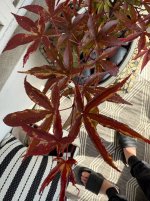Haydz
Seedling
I recently picked up this maple from a pop up shop here in SoCal, I couldn’t say no. Now the plant is usally on my balcony and I have a sun blind to help with some stippled shade for my other maple but up until last week we have been very overcast and cloudy so I’ve had it closest to the open to get as much of that cloudy sun as possible, now where I believe i fucked up was we got an unexpected mini heat wave with blue sky’s, 85-95 F days, and a UV index of 10+ and this little guy was right there to take it all in, since then I have moved him back away and closed my sun curtain to break up some of that immediate sun for a “dappled shade” if you will… now where I am second guessing myself is this maple came in a soil I usually don’t work with, now I’m pretty good at gauging when water is needed and the whole top of the soil came covered in these river stones which seems to keep the moisture in pretty well but now I’m worried that im missing diagnosing sun scorch for over watered or a root problem… I usually only water when the top quarter to half inch is starting to get wet dry, (like it looks darker but when you pinch it in your fingers it kinda crumbles away without anything sticking to your fingers)
So now I take to the bonsai forums lol… what do yall think and what would yall do any and all recommendations are welcome
So now I take to the bonsai forums lol… what do yall think and what would yall do any and all recommendations are welcome





